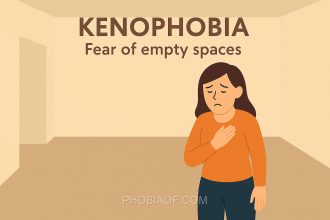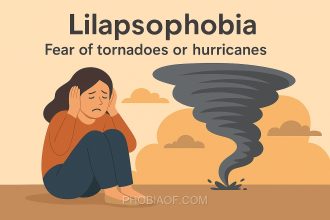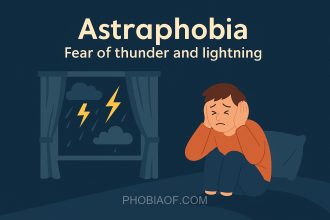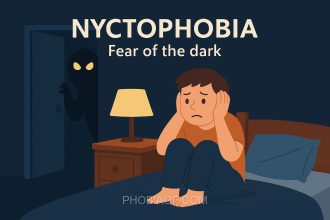Have you ever felt your heart race and palms sweat when peering over a balcony or standing atop a tall building? If so, you’re not alone. This common reaction may be a hint of what some people experience as acrophobia, a more intense fear of heights.
Derived from the Greek words “akron”, meaning peak or summit, and “phobos”, meaning fear, acrophobia is an irrational fear of heights. This isn’t just a mild unease when looking down from a high place; it’s a powerful, often overwhelming fear that can significantly impact one’s daily life.
For those living with acrophobia, the mere thought of climbing a ladder or taking an escalator can trigger anxiety. Symptoms can range from dizziness and sweating to full-blown panic attacks. This fear can also limit everyday activities, such as hiking, visiting tall buildings, or even driving over bridges.
Understanding acrophobia involves recognizing its profound effect on people. It isn’t simply a dislike of heights; it’s a condition that can dictate choices and alter lifestyles. By learning more about this phobia, we can better support those affected and foster a more compassionate environment for everyone.
Causes of Acrophobia
Acrophobia, or the fear of heights, is a common anxiety disorder that can significantly impact a person’s life. Understanding its causes can provide insights into why some individuals develop this phobia while others do not. Several factors may contribute to the onset of acrophobia, ranging from genetic influences to environmental triggers.
Genetic Predisposition
Research suggests that genetics can play a role in the development of acrophobia. If a close family member has a phobia or anxiety disorder, an individual may be more likely to experience similar fears. This genetic predisposition is thought to influence the way the brain processes fear and anxiety.
Traumatic Experiences
Experiencing a traumatic event involving heights, such as a fall or witnessing an accident, can trigger the development of acrophobia. Such experiences can leave a lasting impression on the mind, leading to an intense fear response when confronted with similar situations.
Learned Behavior
Acrophobia can also be a learned behavior. Observing others exhibiting fear of heights, especially during childhood, can influence an individual’s perception of heights as dangerous. Parents or caregivers who express fear of heights may inadvertently pass this fear onto their children.
Psychological and Environmental Factors
Other psychological and environmental factors may contribute to acrophobia. General anxiety disorders can heighten the fear response, making individuals more susceptible to developing specific phobias like acrophobia. Additionally, environmental factors such as living in high-rise buildings or frequently encountering heights in daily life can exacerbate the fear.
Interesting Theories and Research Findings
Some theories suggest that acrophobia may have an evolutionary basis. The fear of heights could have been an adaptive trait, helping early humans avoid dangerous falls. Research continues to explore how visual perception and balance affect the fear of heights, with some studies indicating that individuals with acrophobia might perceive heights differently than those without the phobia.
Overall, acrophobia is likely caused by a combination of genetic, psychological, and environmental factors. Understanding these causes can help in developing effective treatments and coping strategies for those affected by this phobia.
Symptoms of Acrophobia
Acrophobia, the intense fear of heights, can provoke significant anxiety and distress in those affected. This phobia often manifests through a variety of physical, emotional, and behavioral symptoms. Recognizing these symptoms can be the first step in seeking help and understanding this challenging condition.
Physical Symptoms:
- Panic attacks when exposed to heights or even thinking about heights
- Excessive sweating, particularly of the palms
- Rapid heartbeat or palpitations
- Dizziness or a sensation of spinning (vertigo)
- Shortness of breath or hyperventilation
- Trembling or shaking
- Upset stomach or nausea
Emotional and Behavioral Symptoms:
- Overwhelming dread or terror when faced with heights or the anticipation of encountering heights
- Avoidance of situations where exposure to heights is likely, such as bridges, tall buildings, or even climbing ladders
- Anxiety that escalates as one approaches a height or thinks about heights
- Feeling detached from reality or oneself when at a height (derealization or depersonalization)
- Difficulty concentrating due to the fear of heights
- Persistent worry about encountering heights in the future
When severe, the symptoms of acrophobia can significantly interfere with daily life, limiting personal and professional opportunities and causing distress in various situations.
Treatment for Fear of Heights
Overcoming a fear of heights, also known as acrophobia, is absolutely possible with time and the right approach. It’s essential to understand that this phobia can be treated and managed effectively. If you or someone you know struggles with acrophobia, there are several treatment options and coping strategies available that can help.
Proven Therapies:
- Exposure Therapy: This therapy involves gradually and systematically exposing individuals to heights in a controlled manner, helping them face their fear step by step. Starting with less intimidating situations and slowly progressing to more challenging ones can reduce anxiety and build confidence.
- Cognitive-Behavioral Therapy (CBT): CBT aims to change the fearful thoughts associated with heights. By identifying and challenging negative thinking patterns, individuals can develop healthier responses to situations involving heights.
- Counseling: Professional counseling provides a supportive environment to explore underlying issues related to acrophobia. A counselor can offer guidance and strategies tailored to individual needs.
Self-Help Coping Techniques:
- Relaxation Exercises: Techniques such as deep breathing, progressive muscle relaxation, and visualization can help calm the mind and reduce anxiety when facing heights.
- Meditation: Regular meditation practice can improve overall mental health and provide tools to manage anxiety effectively.
- Support Groups: Connecting with others who have similar fears can provide encouragement and shared coping strategies. It can be comforting to know you are not alone in this journey.
In some severe cases, medication such as anti-anxiety drugs might be prescribed by a healthcare professional as a supplementary treatment. However, the focus should primarily be on therapy and developing coping skills.
If acrophobia is interfering with your daily life, it’s important to seek professional help. A mental health professional can guide you through the process and provide the necessary support. Remember, overcoming a fear of heights is a journey, and taking the first step by seeking help is a courageous move towards reclaiming your life.
Conclusion
Understanding the intricacies of acrophobia, from its causes to its symptoms, can empower individuals to take the first steps toward addressing this common fear. Recognizing the patterns and triggers of acrophobia allows those affected to seek appropriate interventions and support systems tailored to their unique experiences.
It is important to remember that overcoming or managing phobias is a journey that many have successfully navigated. With time, patience, and the right resources, it is entirely possible to reduce the impact of acrophobia on one’s life. Whether through therapeutic techniques, gradual exposure, or professional guidance, there exists a pathway to a more confident and less fearful existence.
Remember, you are not alone in this journey. If acrophobia is affecting your daily life, consider reaching out to a therapist or discussing your concerns with a healthcare provider. They can offer valuable support and strategies, helping you to reclaim your experiences and enjoy life more fully.
Let this understanding be a source of hope and inspiration, reminding you that change is possible and support is always within reach.






